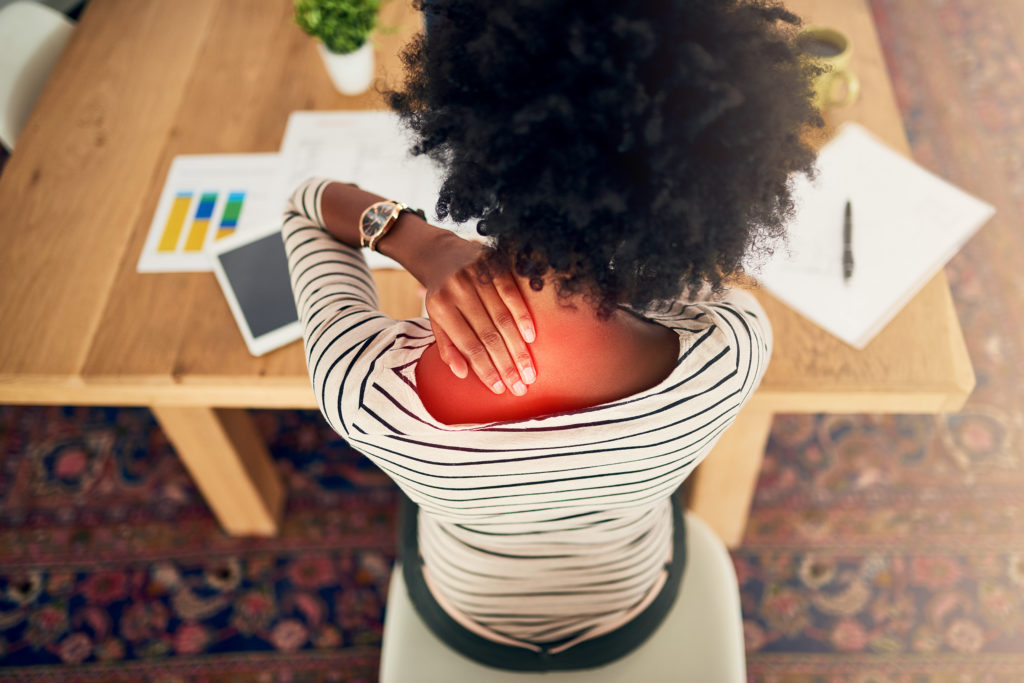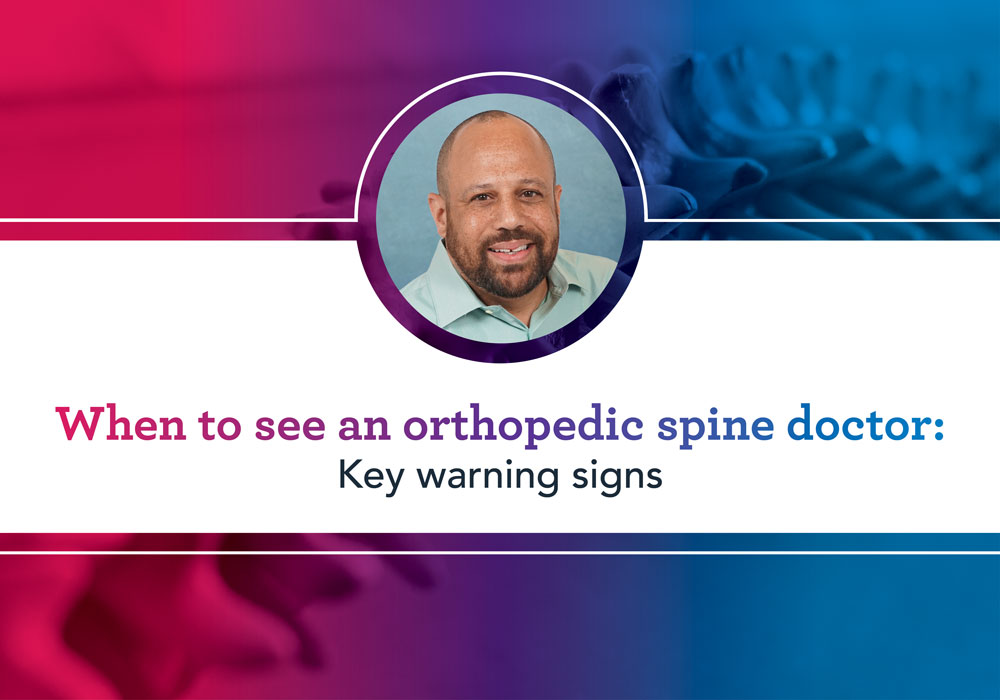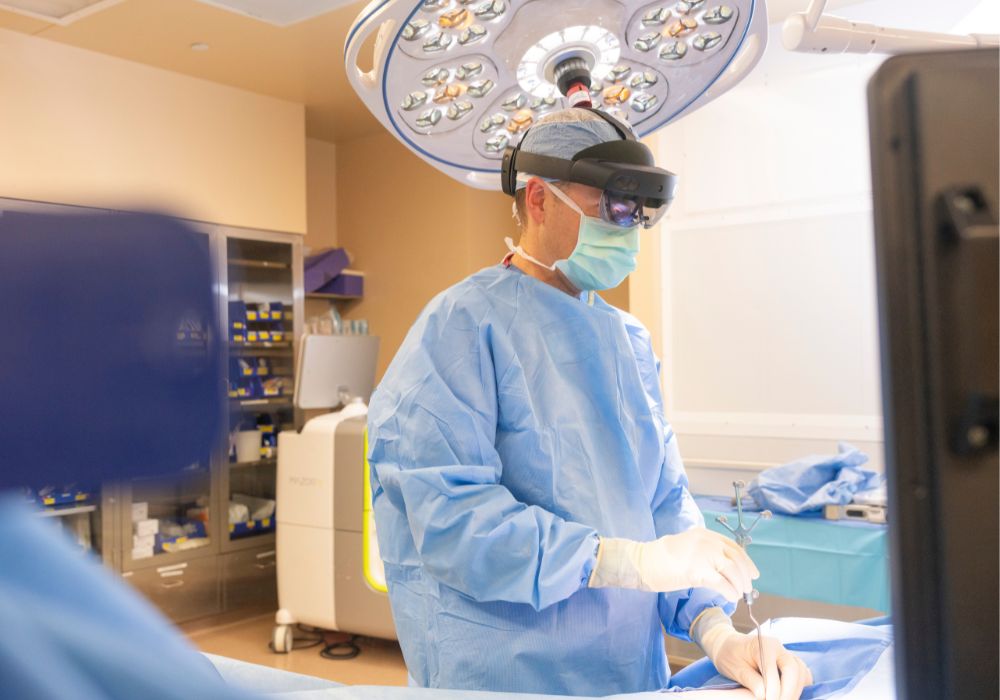THIS POST IS PART OF THE ULTIMATE GUIDE TO BACK PAIN RELIEF
If the pain you are experiencing is in your lower back, you may have a lumbar disc herniation. The pain from herniated disc symptoms come from the pressure and inflammation that is being contacted by the herniated disc material.
Read on to learn what causes common herniated disc symptoms and find out which treatment options are available.
Anatomy
The spine is made up of 24 bones, called vertebrae, which are stacked on top of one another. These bones connect to protect the spinal cord. The seven small vertebrae that begin at the base of the skull and form the neck comprise the cervical spine.
Your spinal cord and nerves travel through the spinal canal carrying messages between your brain and muscles. The intervertebral discs between your vertebrae are flexible, flat, and round discs and are about a half-inch thick. They act as shock absorbers when you walk or run.
A cervical disc herniation is when the soft material of the disc is pushed out onto a nerve in the neck. The discs are the cushions between the bone of the spine that allow for motion between the bones. They are actually very strong early in life. However, at about age 30, they start to become brittle and the strong outer layer may develop cracks that allow the soft inner material to leak out.
Are herniated disc symptoms serious?
A herniated cervical disc is most often caused by worsening changes that occur in the spine as we age or by an injury that causes a herniated or bulging intervertebral disc. Herniated disc symptoms can include severe pain.
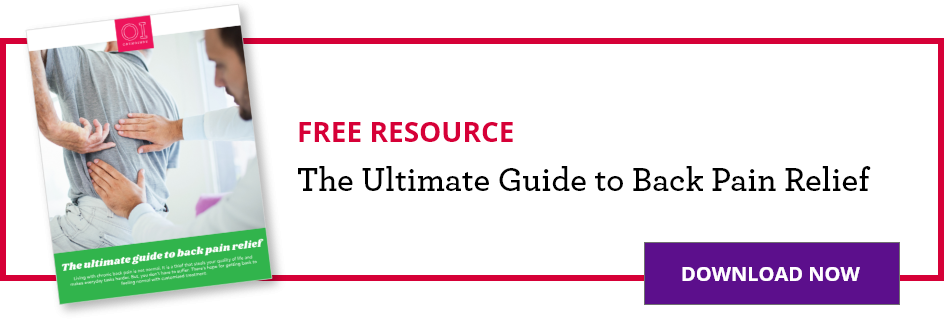
Cervical herniated disc symptoms
Because herniated disc symptoms can be so painful, it is not uncommon for people to come to our urgent care when a herniation first happens. The pain can be a burning, stabbing, or searing discomfort.
It occurs along the nerve, so it tends to start in the neck and radiate down the arm. Sometimes the pain from herniated disc symptoms may just be in the shoulder blade, elbow or wrist depending on which nerve is pinched.
Herniated disc symptoms can also include some amount of numbness in the arm or weakness. The weakness may involve the shoulder, arm, or hand. The pain can be constant although sometimes it is possible to find a comfortable position by resting the arm above the head or bending the neck away from the painful arm.
Physician examination
To determine whether or not what you’re feeling are truly herniated disc symptoms, your physician will ask you for a complete medical history and conduct a physical examination. An X-ray, CT scan, MRI, or EMG can confirm the diagnosis.
MAKE AN APPOINTMENT WITH AN ORTHOINDY SPINE SURGEON
How do you fix a herniated disc?
Many disc herniations will heal on their own with medications, injections, and therapy. Most herniations tend to heal substantially in six to eight weeks.
It is acceptable to monitor a disc herniation if it is only causing pain and not seek treatment. However, if there is weakness, herniated disc symptoms should be watched closely.
If strength is not improving, it is often recommended that the herniation be fixed with surgery to improve the recovery of the nerve. Treatments for alleviating herniated disc symptoms might include:
- Medications
- Injections
- Physical therapy
- Surgery
Medications
The most effective medication to ease herniated disc symptoms—particularly pain—is a course of oral steroids such as prednisone or decadron. These medications can only be taken for several days at a time.
- Nerve medications, such as Gabapentin and Lyrica, may ease the nerve pain of a herniation. However, they can have the side effects of causing drowsiness, but these tend to improve after taking the medication for a few days.
- Anti-inflammatories, such as Motrin and Aleve, may be helpful to ease painful herniated disc symptoms. They function to reduce the inflammation on the nerve, just as steroids do, but they are not as strong as a steroid. These medications thin the blood and cannot be taken for a week prior to any injection or surgery.
- Pain medications, such as Percocet and Norco, tend not to reduce nerve pain. These medications are often prescribed as they may take the edge off the pain but most people are surprised by how little they help.
Injections
Spinal injections can be very helpful for herniated disc symptoms. A spinal injection is a type of epidural that places steroid medication on the nerve where it is being pinched by the herniation.
This allows for a very high concentration of medicine right where it needs to be without the side effects of taking a high dose of steroid by mouth. The medicine stays active for approximately one month.
During that time the herniation can heal. It may take two or three injections over the course of several months to feel relief from herniated disc symptoms.
Physical therapy
Physical therapy can help reduce herniated disc symptoms and the traction may decrease the pressure on the nerve from the disc fragment.
Surgery
Back surgeries for a cervical herniated disc are very effective for getting rid of the pain. The most common procedure for disc herniation is a microdiscectomy. This is a surgery where the herniated disc fragment is simply removed through a small incision.
The surgery takes approximately one hour and is performed as an outpatient procedure.
Surgery is a very good option for patients with severe herniations that are associated with herniated disc symptoms like weakness or severe pain that is not getting better with other treatments.
Cervical disc herniation recovery
A cervical herniated disc can worsen if more disc material is pushed out onto the nerve. While recovering from a herniated cervical disc, we recommend that people avoid:
- Bending
- Lifting more than 15 pounds
- Twisting
- Prolonged sitting
These recommendations usually continue one month beyond the time that a patient feels they have healed from their injury and are feeling some relief from their herniated disc symptoms.
Surgeons are different in their protocols for recovery. In general, it is acceptable to walk up to several miles a day immediately following surgery. Some physicians may start a course of physical therapy and strengthening two weeks after surgery.
During this time, there are still limitations on bending, lifting, and twisting. All restrictions are lifted approximately six weeks after surgery.
Learn more about treatment options for neck and back pain at OrthoIndy.
Schedule an appointment
Are you dealing with herniated disc symptoms? We can help. Schedule online or call us to set up an appointment with one of our orthopedic specialists.
If your injury or condition is recent, you can walk right into one of our OrthoIndy Urgent Care locations for immediate care. For rehabilitation and physical therapy, no referral is needed to see one of our physical therapists.
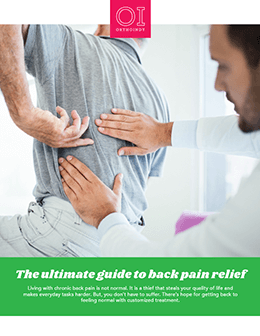
Get the Ultimate Guide to Back Pain Relief
Our comprehensive guide will help you understand back pain and its different causes, like sciatica, herniated disk, scoliosis, pinched nerves and more.


